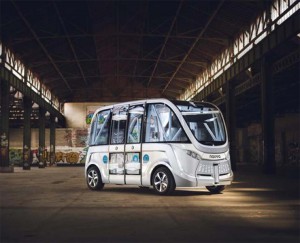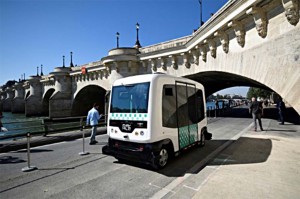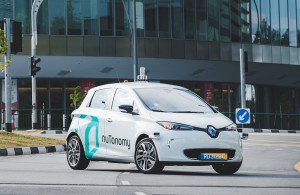Passengers looking to connect between two of the main train stations in Paris might be in for a surprise when hey board one of the new shuttles covering the 400-foot route.
They’re all but certain to note that there is no one behind the wheel. Instead, the two electric minibuses running between the Gare de Lyon and Austerlitz stations are operating driverlessly. But they’re not unique. This week, a new driverless shuttle also went into operation in Las Vegas, running passengers up and down the casino capital’s busy downtown district along Fremont Street.
“Las Vegas has always been on the cutting edge of technology,” Jorge Cervantes, Sin City’s executive director of community development, told the Las Vegas Sun. “We have 40 million visitors a year here and traffic on the Strip and downtown gets very congested. The ability to move people more efficiently is something we’ve been looking at for a while.”
(Budweiser cans the driver; tests driverless truck named Otto to deliver 45,000 cans of beer. Click Here for the story.)
Similar shuttles are being tested in a number of other locations around the world, from Australia to Singapore, the small and densely crowded Asian city-state just launching a pilot program that relies on driverless mini-buses to connect various points in one of its main high-tech development centers.
“This is really a moment in history that’s going to change how cities are built, how we really look at our surroundings,” said Doug Parker, an executive with nuTonomy, a tech spin-off of MIT that is providing the Singapore system.
The company will examine the results of its initial test program and will put 100 or more of of its robo-taxis into operation by 2018, it said last August, when the project was announced.
Autonomous vehicle technology is making the jump from science-fiction to everyday reality, though most of the headlines have focused on passenger cars that will, at least for the near-term, continue to require an “operator” behind the wheel ready to take over in case of trouble. Ford has said it wants to skip that process entirely, moving to entirely driverless vehicles as early as 2021, with Google’s Waymo unit interested in the same approach.
But some believe there may equal, perhaps even greater, opportunity focusing on commercial vehicle applications that could include delivery trucks, heavy-duty haulers and shuttle buses. Those approaches would help by significantly reducing costs, a particularly big plus when it comes to mass transit operations.
(nuTonomy testing its driverless taxis in Boston. Click Here for more.)
Several companies are focusing on shuttles, including Ligier Automobile, a vehicle manufacturing firm based in Abrest, France, founded by former F1 race driver and rugby player Guy Ligier. Its 6-seat, battery-powered EZ10 minibus went into operation along the short Lyon-Austerlitz route this week and will continue running through at least April as part of that pilot program.
It uses GPS and a variety of sensors to safely avoid pedestrians and other obstacles, and runs at a modest 15 kmh, or barely 9 mph. The two shuttles travel across the city’s Charles de Gaulle bridge in separate lanes to minimize any possible problems.
Longer-term, French officials hope that the project will prove it possible to put driverless shuttles and buses into use all over the city, Jean-Louis Missika, a Paris deputy mayor in charge of innovation, declaring that the technology “will change the urban landscape in a spectacular fashion.”
The shuttle running in downtown Las Vegas was developed by Navya, which has operations in both Paris and Lyons, and whose name translates into “praiseworthy” in Sanskrit. The Arma can hold up to 12 passengers. But while it is capable of reaching 27 mph, it will only operate at 12 mph during the current test program – which will mark the first time fully driverless vehicles have operated on public roads in the U.S. on a regular basis.
(Test runs already have been made in Miami and Washington, D.C.)
It’s no surprise to observers that Las Vegas would be the first to try out the technology. With its neon signs and massive video billboards, Sin City is not just a gambling mecca but a center of high technology, underscored by the recent Consumer Electronics Show that spread out across the city.
And Nevada itself has positioned itself as a center of autonomous vehicle research, the first state to pass a law covering the testing of self-driving vehicles, as well as unique license plates adorned with the symbol for infinity.
The opportunities for self-driving vehicles are just about limitless, proponents contend. And the new pilot projects are expected to be just the start.
(Autonomous vehicles could save Americans over $300 billion annually. Click Here to learn how.)



